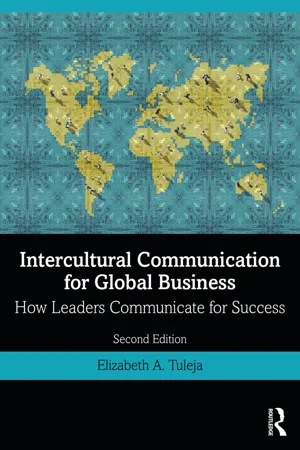
Intercultural Communication for Global Business
How Leaders Communicate for Success
- 314 pages
- English
- ePUB (mobile friendly)
- Available on iOS & Android
Intercultural Communication for Global Business
How Leaders Communicate for Success
About this book
As concise and practical as ever, this new edition brings together principles and new theories in intercultural communication, focusing on communication as the foundation for management and global leadership.
Grounded in the need for building awareness and knowledge, practicing mindfulness, and then working on skill development, this text examines the concepts associated with understanding culture and communication in the global business environment to help readers:
- understand intercultural communication processes;
- improve self-awareness and communication in intercultural settings;
- expand skills in identifying, analyzing, and solving intercultural communication challenges at work; and
- evaluate whether one's communication has been effective.
This fully updated new edition also includes completely updated case studies, with an increased emphasis on non-US perspectives, to show real-world applications across the globe.
Richly illustrated with new examples and activities, this text is the ideal companion for any business student or manager dedicated to communicating more effectively in a globalized society.
Frequently asked questions
- Essential is ideal for learners and professionals who enjoy exploring a wide range of subjects. Access the Essential Library with 800,000+ trusted titles and best-sellers across business, personal growth, and the humanities. Includes unlimited reading time and Standard Read Aloud voice.
- Complete: Perfect for advanced learners and researchers needing full, unrestricted access. Unlock 1.4M+ books across hundreds of subjects, including academic and specialized titles. The Complete Plan also includes advanced features like Premium Read Aloud and Research Assistant.
Please note we cannot support devices running on iOS 13 and Android 7 or earlier. Learn more about using the app.
Information
Part I
Foundations of Intercultural Communication
Chapter 1
Culture in Business Contexts
Chapter Overview

Learning Objectives
Key Takeaways
- Become aware of your own attitudes and assumptions about the importance of culture in leadership.
- Understand that concepts developed within the fields of anthropology, psychology, sociology, and intercultural communication contribute to global leadership principles.
Leadership Applications
- Functional skills are not the same as interpersonal and intercultural skills.
- Leaders need to understand the impact of the “shrinking” world since they must engage people from diverse backgrounds.
Introduction
A Cultural Faux Pas
Whose Rules?
Our Changing World

Why Is Culture Important in Business?
Globalization and Business
Table of contents
- Cover
- Half Title
- Endorsements
- Title Page
- Copyright Page
- Dedication
- Contents
- List of End of Chapter Cases
- List of In My Own Words Caselets
- Foreword
- Preface
- Part I Foundations of Intercultural Communication
- Part II Self-awareness in Intercultural Communication
- Part III Concepts of Intercultural Communication
- Part IV Intercultural Leadership
- Index